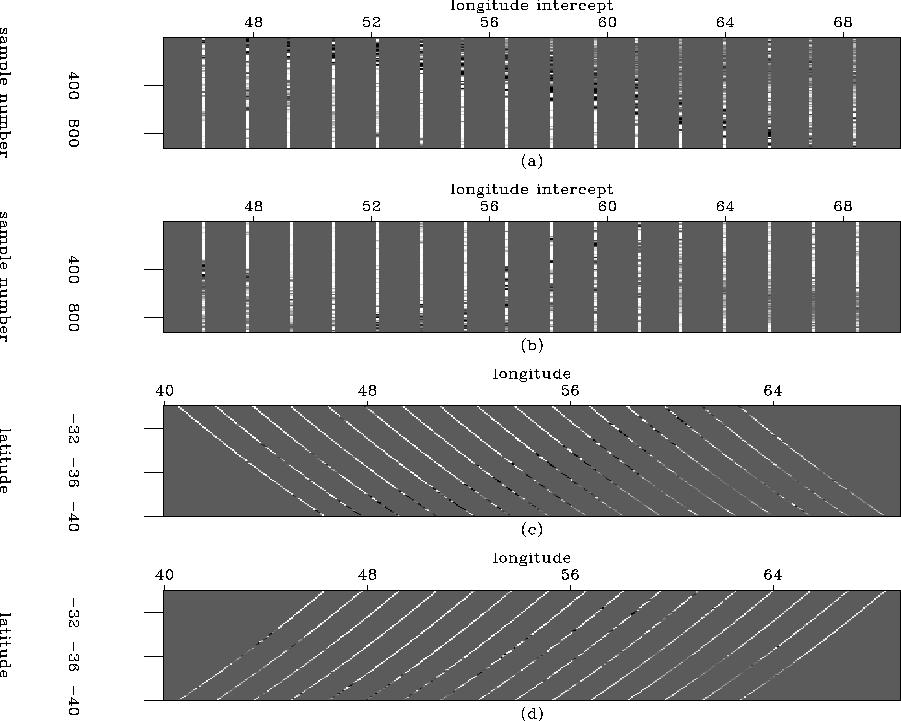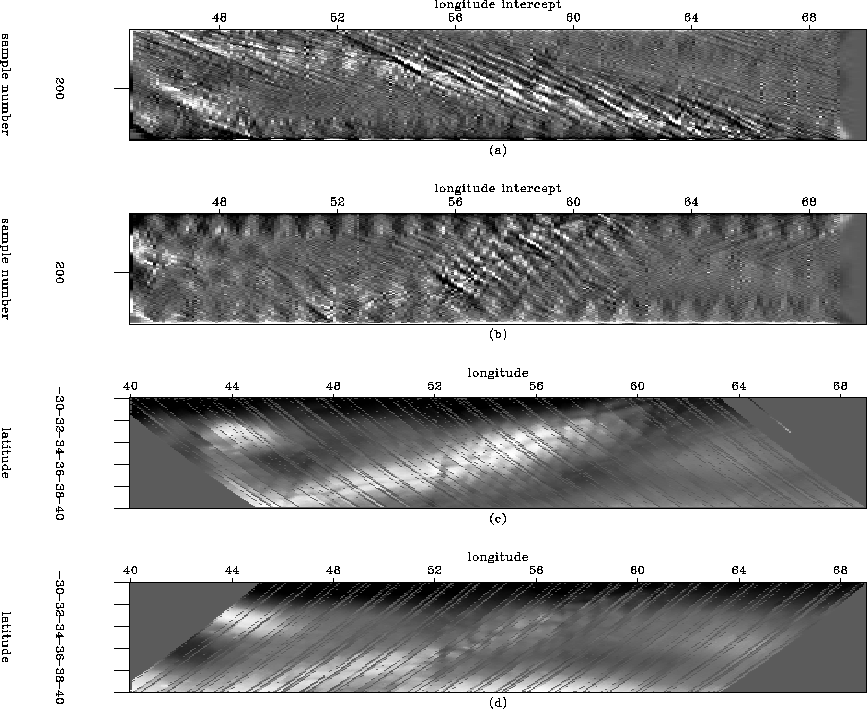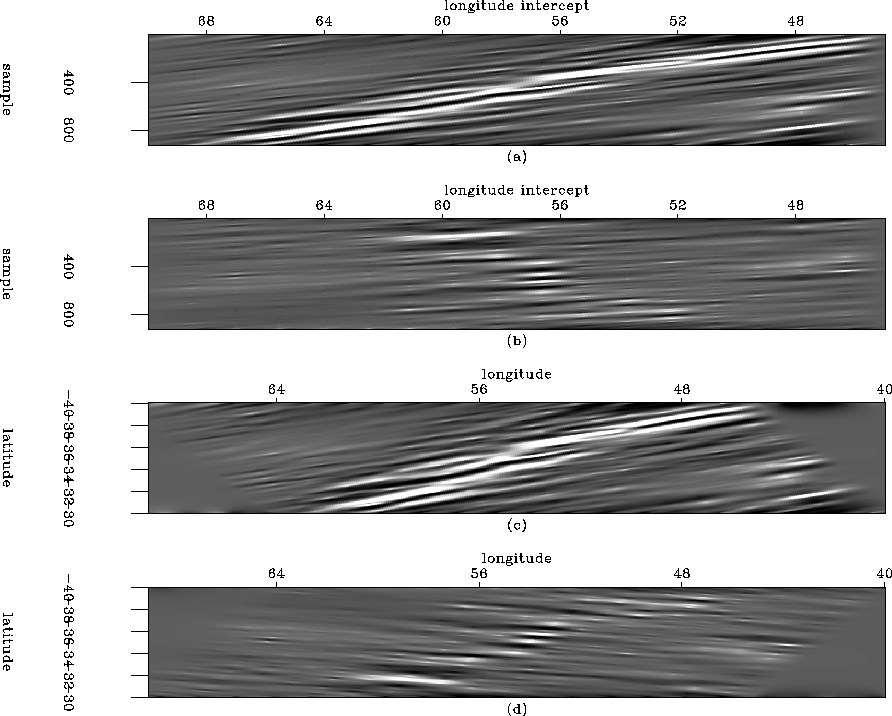 |
Figure 3 Sparse tracks, (a) ascending and (b) descending in model space, and (c) ascending and (d) descending tracks in data space.
![[*]](http://sepwww.stanford.edu/latex2html/movie.gif)
![[*]](http://sepwww.stanford.edu/latex2html/cross_ref_motif.gif) .
However, in the data space of the fitting goals (1) of the previous section, the data are sampled in a
regular space: a series of regularly-sampled tracks, as shown in
Figures
.
However, in the data space of the fitting goals (1) of the previous section, the data are sampled in a
regular space: a series of regularly-sampled tracks, as shown in
Figures ![[*]](http://sepwww.stanford.edu/latex2html/cross_ref_motif.gif) and
and ![[*]](http://sepwww.stanford.edu/latex2html/cross_ref_motif.gif) .
.
 |
![[*]](http://sepwww.stanford.edu/latex2html/movie.gif)
 |
![[*]](http://sepwww.stanford.edu/latex2html/movie.gif)
Since these data are collected in two series of one-dimensional
tracks, it would be easiest to estimate a pair of one-dimensional PEFs
on these two sets of tracks, as shown in the top halfs of Figures
![[*]](http://sepwww.stanford.edu/latex2html/cross_ref_motif.gif) and
and ![[*]](http://sepwww.stanford.edu/latex2html/cross_ref_motif.gif) .
.
We now have two PEFs which have been estimated in a data space, but
the model which we wish to regularize with these PEFs is in a
different space. This requires the introduction of two additional
linear interpolation operators ![]() and
and ![]() , which pull
bins from the model space into the ascending and descending track data
spaces, respectively. The mappings used for these operators are shown
in Figure
, which pull
bins from the model space into the ascending and descending track data
spaces, respectively. The mappings used for these operators are shown
in Figure ![[*]](http://sepwww.stanford.edu/latex2html/cross_ref_motif.gif) .
.
 |
![[*]](http://sepwww.stanford.edu/latex2html/movie.gif)
Now that we have both two prediction-error filters for regularizations operators as well as linear interpolation operators that pull model points into the data space, we can put everthing together in the following fitting goals,
![\begin{eqnarray}
\ {\bf W} \frac{d}{dt}[{\bf L}{\bf m} -{\bf d}] &\approx& {\bf ...
...ld 0 \nonumber \\ \epsilon \bold{A_{2}L_{2}m} &\approx& \bold 0, \end{eqnarray}](img7.gif) |
||
| (3) |
The 1D PEFs can also be replaced by 2D PEFs that are estimated by
scaling the filter so that it covers multiple sparse tracks. If this
approach is taken, the interpolation can occur in the data space where
the PEFs are estimated (using a single PEF for each of the two track
spaces), or in the model space (using both PEFs simultaneously). The
more straightforward data-space interpolation is shown in Figure ![[*]](http://sepwww.stanford.edu/latex2html/cross_ref_motif.gif) .
.
 |
![[*]](http://sepwww.stanford.edu/latex2html/movie.gif)
Figures ![[*]](http://sepwww.stanford.edu/latex2html/cross_ref_motif.gif) a and b are simply the interpolation of
the data space with 2D PEFs estimated on the sparse tracks. Figures
a and b are simply the interpolation of
the data space with 2D PEFs estimated on the sparse tracks. Figures
![[*]](http://sepwww.stanford.edu/latex2html/cross_ref_motif.gif) c and d are those interpolated results mapped
back to the model space by using fitting goals
(1), where the input data are now the interpolated sets of tracks in the
first two panels. Since fitting goals (1) were applied
when generating the new tracks, the track derivative is no longer
necessary.
c and d are those interpolated results mapped
back to the model space by using fitting goals
(1), where the input data are now the interpolated sets of tracks in the
first two panels. Since fitting goals (1) were applied
when generating the new tracks, the track derivative is no longer
necessary.
The results are mixed, as Figure ![[*]](http://sepwww.stanford.edu/latex2html/cross_ref_motif.gif) c shows that
the trend of the ridge was correctly identified by the PEF estimated
on the ascending tracks. The PEF estimated on the descending tracks
did not fare so well, as the direction of the ridge in the interpolated tracks of Figure
c shows that
the trend of the ridge was correctly identified by the PEF estimated
on the ascending tracks. The PEF estimated on the descending tracks
did not fare so well, as the direction of the ridge in the interpolated tracks of Figure
![[*]](http://sepwww.stanford.edu/latex2html/cross_ref_motif.gif) d does not match the densely sampled tracks in
Figure
d does not match the densely sampled tracks in
Figure ![[*]](http://sepwww.stanford.edu/latex2html/cross_ref_motif.gif) d. This is because the descending tracks are
oblique to the structure, so the structure is aliased beyond the point
where a spaced PEF can interpolate accurately. In either case, the
result is better than that obtained with a Laplacian, and in the case
of the ascending tracks is not that far from the PEF estiamted on a
fully-sampled model space shown in Figure
d. This is because the descending tracks are
oblique to the structure, so the structure is aliased beyond the point
where a spaced PEF can interpolate accurately. In either case, the
result is better than that obtained with a Laplacian, and in the case
of the ascending tracks is not that far from the PEF estiamted on a
fully-sampled model space shown in Figure ![[*]](http://sepwww.stanford.edu/latex2html/cross_ref_motif.gif) c.
c.